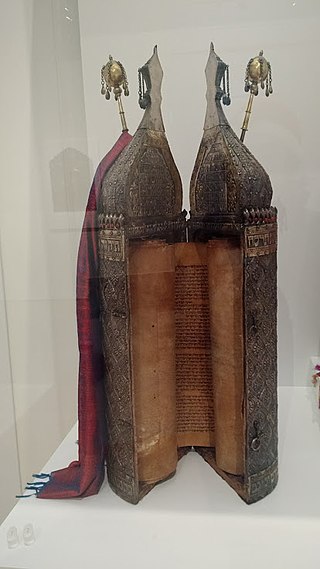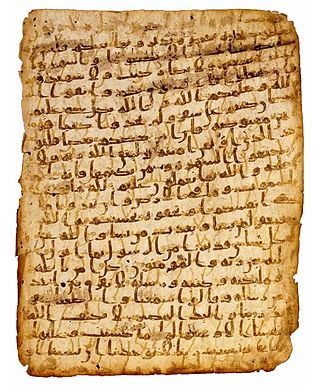
Hadith or Athar refers to what most Muslims and the mainstream schools of Islamic thought believe to be a record of the words, actions, and the silent approval of the Islamic prophet Muhammad as transmitted through chains of narrators. In other words, the ḥadīth are attributed reports about what Muhammad said and did.
In Islam, sunnah, also spelled sunna, are the traditions and practices of the Islamic prophet Muhammad that constitute a model for Muslims to follow. The sunnah is what all the Muslims of Muhammad's time evidently saw and followed and passed on to the next generations. According to classical Islamic theories, the sunnah are documented by hadith, and alongside the Quran are the divine revelation (wahy) delivered through Muhammad that make up the primary sources of Islamic law and belief/theology. Differing from Sunni classical Islamic theories are those of Shia Muslims, who hold that Imams interpret the sunnah, and Sufi who hold that Muhammad transmitted the values of sunnah "through a series of Sufi teachers".

The Quran, also romanized Qur'an or Koran, is the central religious text of Islam, believed by Muslims to be a revelation from God. It is organized in 114 chapters which consist of individual verses. Besides its religious significance, it is widely regarded as the finest work in Arabic literature, and has significantly influenced the Arabic language.
Injil is the Arabic name for the Gospel of Jesus (Isa). This Injil is described by the Qur'an as one of the four Islamic holy books which was revealed by God, the others being the Zabur, the Tawrat, and the Qur'an itself. The word Injil is also used in the Qur’an, the hadith and early Muslim documents to refer to both a book and revelations made by God to Jesus.
Naskh is an Arabic word usually translated as "abrogation". In tafsir, or Islamic legal exegesis, naskh recognizes that one rule might not always be suitable for every situation. In the widely recognized and "classic" form of naskh, one ḥukm "ruling" is abrogated to introduce an exception to the general rule, but the text the ḥukm is based on is not repealed.

The Tawrat, also romanized as Tawrah or Taurat, is the Arabic-language name for the Torah within its context as an Islamic holy book believed by Muslims to have been given by God to the prophets and messengers amongst the Children of Israel. In the Qur'an, the word 'Tawrat' occurs eighteen times. When referring to traditions from the Tawrat, Muslims have not only identified it with the Pentateuch, but also with the other books of the Hebrew Bible as well as with Talmudic and Midrashic writings.
Indeed, We sent down the Torah, in which was guidance and light. The prophets who submitted [to God] judged by it for the Jews, as did the rabbis and scholars by that with which they were entrusted of the Scripture of God, and they were witnesses thereto. So do not fear the people but fear Me, and do not exchange My verses for a small price [i.e., worldly gain]. And whoever does not judge by what God has revealed - then it is those who are the disbelievers.
The history of the Quran, the holy book of Islam, is the timeline and origin of the written compilations or manuscripts of the Quran, based on historical findings. It spans several centuries, and forms an important major part of the early history of Islam.
Ahl al-Ḥadīth is an Islamic school of Sunni Islam that emerged during the 2nd and 3rd Islamic centuries of the Islamic era as a movement of hadith scholars who considered the Quran and authentic hadith to be the only authority in matters of law and creed. They were known as "Athari" for championing traditionalist theological doctrines which rejected rationalist approaches and advocated a strictly literalist reading of Scriptures. Its adherents have also been referred to as traditionalists and sometimes traditionists. The traditionalists constituted the most authoritative and dominant bloc of Sunni orthodoxy prior to the emergence of mad'habs during the fourth Islamic century.
Various sources of Islamic Laws are used by Islamic jurisprudence to elaborate the body of Islamic law. In Sunni Islam, the scriptural sources of traditional jurisprudence are the Holy Qur'an, believed by Muslims to be the direct and unaltered word of God, and the Sunnah, consisting of words and actions attributed to the Islamic prophet Muhammad in the hadith literature. In Shi'ite jurisprudence, the notion of Sunnah is extended to include traditions of the Imams.

Interactions between Muslims and Hindus began in the 7th century, after the advent of the former in the Arabian Peninsula. These interactions were mainly by trade throughout the Indian Ocean. Historically, these interactions formed contrasting patterns in northern and southern India. While there is a history of conquest and domination in the north, Hindu-Muslim relations in Kerala and Tamil Nadu have been peaceful. However, historical evidence has shown that violence had existed by the year 1700 A.D.
Miracles of Muhammad are miraculous happenings attributed to the Islamic prophet Muhammad.

Islamic holy books are certain religious scriptures that are viewed by Muslims as having valid divine significance, in that they were authored by God (Allah) through a variety of prophets and messengers, including those who predate the Quran. Among the group of religious texts considered to be valid revelations, the three that are mentioned by name in the Quran are the Tawrat, received by prophets and messengers amongst the Children of Israel; the Zabur (Psalms), received by David; and the Gospel, received by Jesus. Additionally, the Quran mentions God's revealing of the Scrolls of Abraham and the Scrolls of Moses.
The Scrolls of Moses are an ancient body of scripture mentioned twice in the Quran, as well as in Surah Al-Aʻlā and Surah An-Najm. They are part of the religious scriptures of Islam.
The Quran states that several prior writings constitute holy books given by God to the prophets and messengers amongst the Children of Israel, in the same way the Quran was revealed to Muhammad. These include the Tawrat, believed by Muslims to have been given by God to the prophets and messengers amongst the Children of Israel, the Zabur revealed to David (Dawud); and the Injil revealed to Jesus (Isa).
Prophets in Islam are individuals in Islam who are believed to spread God's message on Earth and serve as models of ideal human behaviour. Some prophets are categorized as messengers, those who transmit divine revelation, most of them through the interaction of an angel. Muslims believe that many prophets existed, including many not mentioned in the Quran. The Quran states: "And for every community there is a messenger." Belief in the Islamic prophets is one of the six articles of the Islamic faith.
The Shafi'i school or Shafi'ism is one of the four major schools of Islamic jurisprudence within Sunni Islam. It was founded by the Muslim scholar, jurist, and traditionist al-Shafi'i, "the father of Muslim jurisprudence", in the early 9th century.
Quranism is an Islamic movement that holds the belief that the Quran is the only valid source of religious belief, guidance and law in Islam. Quranists believe that the Quran is clear, complete, and that it can be fully understood without recourse to the hadith and sunnah. Therefore, they use the Quran itself to interpret the Quran, an exegetical principle known as tafsir al-Qur'an bi al-Qur'an.
Canonized Islamic scripture are texts which Muslims believe were revealed by God through various prophets throughout humanity's history—specifically the Quran and Hadith. Muslims believe the Quran to be the final revelation of God to mankind, and a completion and confirmation of previous scriptures. It was believed to have been revealed to the Islamic prophet Muhammad from 620 CE to 632 CE, and canonized in an official, unified text during the caliphate of Rashidun Uthman, around 650 CE.







